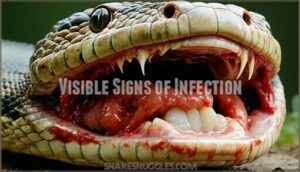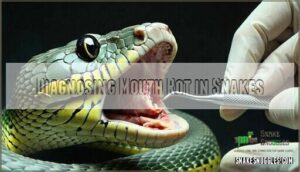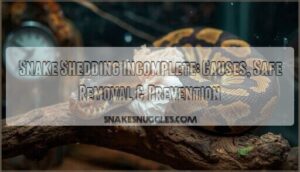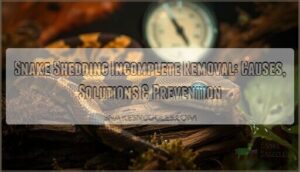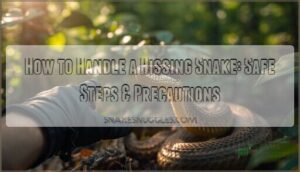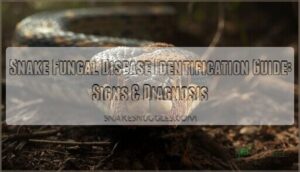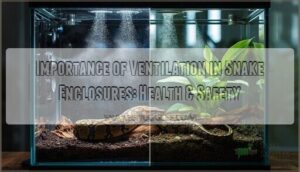This site is supported by our readers. We may earn a commission, at no cost to you, if you purchase through links.

You’ll notice purulent discharge, excessive mucous, swelling, or reddening around the mouth.
Your snake may also show anorexia, inability to close its mouth, or reduced tongue flicking.
These symptoms can indicate mouth rot, a serious condition.
By recognizing these signs, you’re taking the first step in identifying the issue, and understanding the causes and treatment options will help you take action to protect your pet’s health, which is essential for its well-being and survival.
Table Of Contents
- Key Takeaways
- What is Snake Mouth Rot?
- Common Signs of Mouth Rot in Snakes
- What Causes Mouth Rot in Snakes?
- Ball Python Mouth Rot Symptoms
- Diagnosing Mouth Rot in Snakes
- Treating Mouth Rot in Snakes
- Prevention of Mouth Rot in Snakes
- Ball Python Specific Care and Prevention
- Common Health Issues in Snakes
- General Snake Care and Health Tips
- Frequently Asked Questions (FAQs)
- How to tell if a snake has mouth rot?
- How to treat mouth rot in a snake at home?
- Can mouth rot be treated?
- How much does it cost to treat mouth rot in snakes?
- How to tell if your snake has mouth rot?
- How to get rid of mouth rot in snakes?
- Is mouth rot treatable?
- How common is mouth rot in ball pythons?
- Can mouth rot be transmitted between snakes in close proximity?
- How often should a snakes mouth be inspected for rot?
- Conclusion
Key Takeaways
- You’ll notice snake mouth rot by looking for purulent discharge, excessive mucous, swelling, or reddening around the mouth, which can indicate a serious bacterial infection.
- Your snake may show anorexia, inability to close its mouth, or reduced tongue flicking, and you should monitor its appetite and weight to catch any issues early on.
- You can prevent mouth rot in snakes by maintaining proper husbandry conditions, including a clean enclosure, proper nutrition, and regular health checks, which will help reduce the risk of bacterial infections.
- If you suspect mouth rot, you should take your snake to a vet for a proper diagnosis and treatment plan, which may include antibiotics, cleaning, and supportive care to help your snake recover from this potentially fatal condition.
What is Snake Mouth Rot?
Snake mouth rot, also called infectious stomatitis, is a bacterial infection that damages the tissues in and around a snake’s mouth.
Snake mouth rot is a bacterial infection damaging tissues in a snake’s mouth.
You’ll notice it causes swelling, redness, and sometimes sores, making eating and breathing difficult for your pet, which is a result of the bacterial infection.
Definition of Mouth Rot
Snake mouth rot, or infectious stomatitis, is a bacterial infection that strikes all snake species.
This painful condition attacks your snake’s oral tissues, creating swelling and eating difficulties that can prove fatal without treatment.
- Tissue damage spreads rapidly through mouth structures
- Eating becomes impossible as pain intensifies with each attempt
- Bacterial overgrowth destroys healthy oral tissue
- Fatal outcomes occur when infection reaches critical stages
Most snakes recover completely with proper veterinary care and treatment.
Causes of Mouth Rot
When Hygiene Practices slip or Environmental Stressors pile on, bacteria, viruses, and fungi get their shot.
Nutritional Deficiencies, like malnutrition, weaken your snake’s defenses. Add Oral Trauma—think scrapes or bites—and snake mouth rot starts brewing.
Poor husbandry and Immune Suppression, from stress or illness, create the perfect storm.
Here’s a quick breakdown:
| Cause | Effect | Example |
|---|---|---|
| Poor husbandry | Immune suppression | Dirty enclosures |
| Nutritional issues | Weak immunity | Vitamin deficiencies |
| Oral trauma | Bacterial entry | Mouth injuries |
| Stressful environment | Lower defense | Too low humidity |
| Infection | Tissue damage | Bacterial overgrowth |
Common Clinical Signs of Mouth Rot
Recognizing early symptoms helps you catch snake mouth rot before it becomes serious.
Watch for oral discharge, swollen gums, and tissue damage around the mouth area. Your snake might show breathing issues like open-mouth breathing or refuse food completely.
These behavioral changes, combined with bloody saliva and foul odors, indicate snake stomatitis requiring immediate veterinary attention.
Common Signs of Mouth Rot in Snakes
You’ll recognize mouth rot in your snake by looking for several telltale signs that indicate bacterial infection in the oral cavity.
The most obvious symptoms include red, swollen tissue around the mouth, bloody saliva or discharge, loss of appetite, and visible bleeding or pus-filled lesions.
Red Areas or Swellings in The Mouth
The telltale red areas and swellings in your snake’s mouth signal inflammation causes from bacterial infection.
These severity indicators appear as patches of hemorrhage on gums, ranging from pinpoint spots to larger inflamed regions.
Snake mouth rot creates visible tissue damage through swollen, discolored oral tissues.
Differential diagnosis requires examining these red areas alongside other snake stomatitis symptoms to distinguish snake mouth infection from minor irritation, which involves looking at the severity indicators and the overall tissue damage.
Blood in The Mouth or Bloody Saliva
Bloody discharge signals a serious snake mouth infection that demands immediate attention.
Fresh blood appears bright red, while older blood looks darker and clotted.
The saliva consistency changes from normal clear fluid to thick, contaminated discharge.
Key blood-related symptoms include:
- Blood Appearance – Bright red fresh blood or dark clotted material
- Saliva Consistency – Thick, mucus-like discharge mixed with blood
- Bleeding Causes – Bacterial infection destroying mouth tissue
- Severity Levels – Light spotting to heavy bleeding patterns
- Treatment Options – Immediate veterinary care with antibiotic therapy
Unsanitary conditions can foster bacterial and fungal growth in the snake’s enclosure.
Loss of Appetite and Weight Loss
Notice your snake’s appetite dwindling? Monitor food intake and weight.
| Signs | Effects |
|---|---|
| Loss of appetite | Weight loss |
| Digestive Issues | Nutritional Deficiencies |
| Parasitic Infections | Stress Factors |
| Metabolic Disorders | Snake mouth rot |
This monitoring is crucial for identifying potential health issues, such as digestive problems, early on.
Discharge or Bleeding in or Around The Mouth
When checking your snake’s mouth, look for discharge or bleeding, which can indicate snake mouth rot.
Discharge types and bleeding severity vary, requiring an oral examination to determine the infection source.
Treatment options depend on the severity, addressing the root cause of the bloody discharge or bloody saliva.
What Causes Mouth Rot in Snakes?
You’re likely wondering what causes mouth rot in snakes, and it’s vital to understand that poor husbandry and hygiene, malnutrition, and mouth injuries can all contribute to this condition.
Poor husbandry and hygiene can lead to mouth rot in snakes, a serious condition.
By identifying these causes, you can take steps to prevent mouth rot in your snake and make certain it receives the proper care it needs to thrive.
Poor Husbandry and Hygiene
You’re responsible for keeping your snake’s enclosure clean.
Poor husbandry and hygiene, such as inadequate disinfection and unsanitary conditions, can lead to snake mouth rot, a bacterial infection.
Regular enclosure cleaning and water sanitation are essential to prevent this issue.
Malnutrition and Vitamin Deficiencies
You can prevent snake mouth rot by avoiding dietary imbalances and vitamin deficiencies.
Consider:
- Prey gut-loading
- Supplementation risks
- Vitamin absorption
- Nutrient gaps to keep your snake healthy and prevent malnutrition, reducing the risk of snake mouth rot.
This approach will help keep your snake healthy and prevent malnutrition.
Mouth Injuries and Trauma
You can prevent mouth injuries by inspecting enclosures for hazards and handling snakes gently.
Consider:
- Avoiding sharp objects
- Preventing toxic exposure
- Minimizing handling trauma to prevent snake mouth rot and mouth sores.
This approach helps in preventing injuries and ensuring the well-being of the snakes.
Weakened Immune System
A weakened immune system, often due to stress factors, nutritional deficiencies, or genetic predisposition, makes your snake more susceptible to mouth rot.
This susceptibility increases the risk of secondary infections and poor husbandry, which can exacerbate the mouth rot appearance and visible signs of infection.
Ball Python Mouth Rot Symptoms
You’ll want to recognize the symptoms of mouth rot in your ball python, as it can be a serious condition if left untreated.
By knowing what to look for, you can identify visible signs of infection, such as open-mouth breathing and excessive salivation, and take action to guarantee your pet receives proper care.
Visible Signs of Infection
You’ll notice oral redness, swollen gums, or bloody discharge, indicating snake mouth rot.
Inspect your ball python’s mouth for blisters, ulcers, or tissue necrosis.
Visible signs of infection, like nasal discharge, require immediate veterinary attention to prevent worsening.
Look for these symptoms to guarantee your snake’s health and well-being.
Open-Mouth Breathing and Excessive Salivation
You’re observing your ball python’s behavior, and now you notice open-mouth breathing and excessive salivation.
Watch for:
- Labored breathing or hissing sounds
- Bubbles or foam around the mouth
- A swollen throat, indicating potential Respiratory Distress or Aspiration Risk from snake mouth rot.
Diagnosing Mouth Rot in Snakes
You’ll need to examine your snake’s mouth and overall health to diagnose mouth rot, looking for signs like redness, swelling, and discharge.
By working with a veterinarian, you can determine the best course of action, which may include physical exams, cytology, and imaging studies to confirm the diagnosis.
Physical Examination
When examining your snake for mouth rot, you’ll work closely with your vet.
They’ll perform an oral observation, using palpation techniques to check for swelling and lesions.
Anesthesia may be needed for a thorough exam.
Equipment required includes a good light source and magnification.
Lesion assessment is key to diagnosing snake mouth rot, snake oral disease, or snake mouth sores.
| Equipment | Lesion Assessment |
|---|---|
| Light source | Oral lesions |
| Magnification | Mouth sores |
| Anesthesia | Swelling check |
| Palpation | Lesion size |
| Observation | Snake mouth rot |
Cytology and Cultures
How do veterinarians pinpoint the exact cause of snake mouth rot? Through cytology and cultures, your vet collects samples from infected areas for detailed microscopic analysis and bacterial identification.
Veterinarians may also conduct blood work to assess underlying conditions.
This diagnostic process involves:
- Sample collection using sterile swabs from mouth discharge
- Bacterial identification through culture growth and staining techniques
- Antibiotic sensitivity testing to determine effective treatments
- Fungal cultures to rule out secondary infections
- Microscopic analysis revealing bacteria, blood cells, and tissue damage.
These tests guide targeted treatment by identifying specific pathogens causing the bacterial infection.
Biopsy and Imaging Studies
Advanced diagnostic techniques help veterinarians confirm mouth rot diagnosis and assess infection severity.
These methods provide detailed tissue analysis and lesion identification for accurate treatment planning.
- Biopsy techniques – Tissue sampling from affected oral areas reveals bacterial, fungal, or viral infections
- Imaging modalities – X-rays and CT scans show bone involvement and infection spread
- Diagnostic accuracy – Combined testing guarantees proper identification of causative organisms
- Veterinary care – Professional evaluation determines appropriate treatment protocols for snake mouth rot
Unsanitary conditions often lead to bacterial and fungal growth, exacerbating the condition.
Treating Mouth Rot in Snakes
You’ll need to take your snake to a vet for a proper diagnosis and treatment plan if you suspect mouth rot.
You can help treat mouth rot in snakes by following the vet’s instructions, which may include antibiotics, cleaning, and supportive care to help your snake recover.
Mild Cases and Home Care
When treating mild snake mouth rot cases at home, focus on early detection, gentle cleaning techniques, and topical treatments.
Provide dietary support to reduce redness and swelling, and monitor progress closely to confirm effective home care for your snake.
Many owners find success using specialized reptile products for mild snake mouth rot cases, and it is crucial to follow a careful approach to ensure the best outcome with topical treatments.
Severe Cases and Veterinary Treatment
You’re dealing with a severe case of snake mouth rot. Rush to a vet for emergency care, which may include surgical intervention, hospitalization, and advanced medications to stabilize the situation and improve prognosis factors for long-term care and recovery from severe cases of snake mouth rot.
Maintaining proper terrarium conditions is vital because a weakened immune system can lead to mouth rot.
Antibiotics and Pain Relief
After addressing severe cases, let’s consider antibiotics and pain relief.
For snake treatment, antibiotics are often needed. You’ll work with your vet to find the best plan.
- Antibiotic Types: Your vet might prescribe snake antibiotics to fight infection.
- Pain Management: Managing pain is key for comfort. Your vet may use meloxicam.
- Dosage Calculation: Accurate dosing is vital for your snake’s safety.
- Resistance Risks: Overuse of antibiotics can lead to resistance.
Keep the infection under control and monitor if the antibiotics are working.
Supportive therapies can also help, including ensuring optimal environmental conditions to promote healing.
Surgical Treatment and Hospitalization
In severe cases, surgical treatment involves removing dead tissue through debridement techniques under anesthesia.
Your snake requires hospitalization for post-op care, including fluid therapy and pain management.
While anesthesia risks exist, skilled veterinarians minimize complications.
Hospitalization costs vary, but prognosis factors improve substantially with prompt surgical intervention for abscesses and advanced snake mouth rot infections.
Prevention of Mouth Rot in Snakes
You can prevent mouth rot in snakes by maintaining proper husbandry conditions and staying vigilant about their health.
Regular monitoring, clean environments, and proper nutrition form the foundation of effective prevention strategies.
Proper Husbandry and Hygiene
Preventing snake mouth rot starts with maintaining excellent hygiene and proper husbandry practices.
Clean enclosures create healthy environments that reduce bacterial growth and infection risk.
Follow these essential hygiene practices:
- Enclosure Cleaning – Remove waste and uneaten food immediately, then disinfect surfaces weekly
- Water Sanitation – Replace water bowls every 3-4 days with fresh, dechlorinated water
- Substrate Choice – Use appropriate bedding like aspen shavings that won’t harbor bacteria
- Handling Practices – Wash hands before and after handling to prevent contamination
- Quarantine Protocols – Isolate new snakes for 30 days before introducing them
Poor husbandry directly contributes to reptile mouth rot by weakening your snake’s immune system and creating conditions where harmful bacteria thrive.
Nutritious Diet and Vitamin Supplements
A nutritious diet keeps reptile mouth rot at bay, so feed a variety of prey rich in Vitamin A and use Calcium sources wisely.
Prey gutloading boosts nutrients, while sticking to a supplement schedule prevents gaps—or overdoses.
Hydration importance can’t be overstated, and healthy foods along with smart vitamin supplements help you avoid the classic mouth rot appearance and keep your snake thriving.
Many owners find it convenient to buy snake vitamins online, which can be a part of a supplement schedule.
Regular Health Checks and Monitoring
You’ll prevent snake mouth rot by scheduling regular health checks, including visual inspections and weight monitoring, to detect signs of disease, such as behavior changes, early.
Ensuring early detection and prompt treatment.
Humidity and Temperature Control
To prevent mouth rot, maintain ideal humidity and temperature gradients.
Keep humidity at 50-65% and provide basking spots with good ventilation, ensuring a healthy environment for your snake by controlling environmental factors like humidity and temperature.
Ball Python Specific Care and Prevention
You’ll want to focus on maintaining ideal humidity levels and temperature control for your ball python to prevent mouth rot.
By keeping a clean enclosure and removing waste regularly, you can substantially reduce the risk of your ball python developing this common health issue, specifically mouth rot.
Humidity Levels and Temperature Control
To keep your ball python healthy, consider these 5 tips:
- Maintain 50-65% humidity
- Create temperature gradients
- Calibrate your thermostat
- Provide basking spots
- Make seasonal adjustments.
Ideal temperatures should range from 88-92°F on the basking side and 78-80°F on the cool side, and can be found in more detail at Ideal temperatures.
Humidity and temperature control are essential for your pet’s well-being, ensuring a comfortable environment with proper humidity control and temperature gradients.
Clean Enclosure and Waste Removal
You’re responsible for maintaining a clean enclosure to prevent snake mouth rot.
| Cleaning Task | Frequency |
|---|---|
| Remove waste | Daily |
| Disinfect enclosure | Weekly |
| Change substrate | Monthly |
Proper waste disposal and disinfecting enclosures are vital for hygiene and preventing bacterial infection. You can find a suitable enclosure cleaner online to help with preventing bacterial infection.
Common Health Issues in Snakes
You’ll encounter various health issues in snakes, including signs of disease and infection, external parasites, and respiratory problems.
As you care for your snake, being aware of these common health issues is vital to provide the best possible care and prevent complications, which is crucial for the snake’s well-being and requires awareness of potential problems.
Signs of Disease and Infection
You’re monitoring your snake’s health, watching for early symptoms of disease and infection.
Check for:
- Pale mucous membranes
- Mucous or white discharge
- Lumps or swelling
- Skin shedding issues.
Visible tissue damage, pus discharge, and behavioral changes can indicate snake mouth rot.
Look for snake mouth swelling, redness, or discharge.
Early detection is key to preventing advanced stages.
External Parasites and Mites
Check your snake for external parasites like mites, which can cause anemia and stress.
Look for tiny, moving dots or a dusty appearance on scales.
Mite identification is key to parasite prevention and treatment options, ensuring enclosure hygiene to prevent secondary infections and snake mouth rot.
Respiratory Issues and Pneumonia
You’ll notice labored breathing, lethargy, or loss of appetite in snakes with respiratory issues like pneumonia.
Maintain proper humidity levels to prevent respiratory problems, as breathing difficulty can lead to secondary infections, worsening respiratory distress and potentially causing snake mouth rot.
Skin Problems and Shedding Issues
You’ll encounter shedding issues, like stuck shed or skin discoloration, due to Dysecdysis Causes or Mite Infestations.
These issues can lead to Scale Rot, Retained Spectacles, and even snake mouth rot, characterized by redness, swelling, blisters, or sores.
This can affect your snake’s overall health and Shedding Frequency.
General Snake Care and Health Tips
You’re taking the first step in learning about general snake care and health tips to prevent issues like mouth rot.
By following proper care and health guidelines, you can help keep your snake healthy and thriving, and reduce the risk of diseases and infections, which is a key part of general snake care.
Selecting a Healthy Snake
When selecting a healthy snake, choose a reputable breeder with strict quarantine protocols.
Ask about breeding history, temperament assessment, and physical examination to verify you’re getting a snake without signs of disease, like snake mouth rot.
This will help ensure you’re getting a healthy pet.
Housing and Temperature Requirements
Housing your snake involves careful planning. For neonates, a 20-gallon tank is a minimum. Verify a 3/4 square foot floor space per foot of snake.
You’ll want a temperature gradient setup with a basking site around 90-95F. Heating Methods will keep your snake cozy. Humidity control systems help maintain the perfect Humidity Levels.
Substrate Choice matters too. A clean enclosure prevents Snake mouth rot.
- A happy snake is a healthy snake.
- Consistent temperature control is key.
- Proper humidity prevents many issues.
Feeding and Nutrition Guidelines
You research dietary needs, considering prey size and feeding frequency.
Make certain proper supplementation, hydration, and diet variety to prevent snake eating problems, like loss of appetite, and provide necessary nutritional support.
Handling and Socialization Tips
You handle your snake with care.
To reduce stress, follow these tips:
- Support their body
- Move slowly
- Be patient.
Gentle handling aids in socialization, benefiting snake temperament and reducing stress, which can help prevent issues like snake mouth rot.
Frequently Asked Questions (FAQs)
How to tell if a snake has mouth rot?
Look for swollen gums, redness, bloody or pus-filled discharge, and loss of appetite in your snake.
If your scaly buddy’s jawline looks puffy or they’re drooling, those are big, blinking warning lights for mouth rot.
How to treat mouth rot in a snake at home?
Clean your snake’s mouth gently with diluted Betadine using a cotton swab, but don’t skip a vet visit.
Support recovery by improving enclosure hygiene, temperature, and humidity, and make sure your snake keeps eating.
Avoid harsh home treatments, and ensure you follow the instructions carefully to support your snake’s recovery, focusing on improving its environment.
Can mouth rot be treated?
About 80% of snakes fully recover from mouth rot with prompt treatment.
You’ll need antibiotics, vet care, and a clean home for your snake.
Left untreated, though, mouth rot can do real damage, even becoming fatal.
How much does it cost to treat mouth rot in snakes?
You’ll likely spend between $50 to $200 or more to treat mouth rot in snakes, depending on the severity and required veterinary care, including antibiotics and potential surgery.
How to tell if your snake has mouth rot?
You’ll notice symptoms like loss of appetite, redness, swelling, and discharge around your snake’s mouth, indicating potential mouth rot, a serious bacterial infection requiring prompt veterinary attention and care.
How to get rid of mouth rot in snakes?
You’ll need to treat mouth rot in snakes with antibiotics, proper cleaning, and supportive care, under veterinary guidance, to guarantee effective recovery and prevent complications.
Is mouth rot treatable?
You’ll be relieved to know that mouth rot is totally treatable with antibiotics, proper care, and a clean environment, so don’t panic, you can save your snake.
How common is mouth rot in ball pythons?
You’ll find mouth rot fairly common in ball pythons, especially those in poor conditions, due to bacterial infections and stress, affecting their overall health and well-being substantially.
Can mouth rot be transmitted between snakes in close proximity?
You’ll be relieved to know that mouth rot isn’t typically contagious between snakes, but poor hygiene can spread bacteria, so keep their enclosures clean.
How often should a snakes mouth be inspected for rot?
You should inspect your snake’s mouth daily for signs of rot, looking for redness, swelling, or discharge, and schedule regular vet checkups to catch any issues early on.
Conclusion
Recognizing the signs of snake mouth rot is key.
You’re now aware of what snake mouth rot looks like, including purulent discharge and swelling.
By understanding these signs, you’ll take action to protect your pet’s health, addressing the question of what does snake mouth rot look like and taking steps for essential treatment and prevention.
- https://arav.org/
- https://www.merckvetmanual.com/exotic-and-laboratory-animals/reptiles/bacterial-diseases-of-reptiles?query=stomatitis
- https://lafeber.com/vet/presenting-problem-stomatitis-in-reptiles/
- https://www.reptilehealth.com/
- https://www.sierraclub.org/sierra/ask-mr-green/2014/03/hey-mr-green-it-more-ecofriendly-use-rags-or-paper-towels






